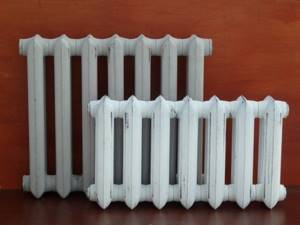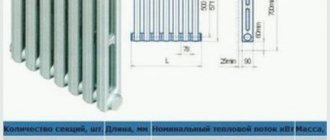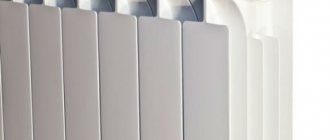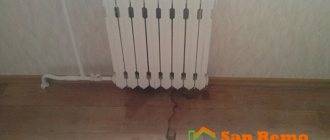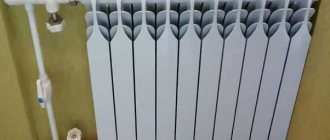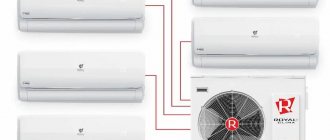Many people can lift this weight. But only film actors can stretch it like accordion bellows.
How much can an old-style cast iron battery weigh? There is no average value for the simple reason that there are a huge number of models in use on the heating market, differing not only in appearance, but also in technical parameters. But I know the answer, and I’m ready to share with you.
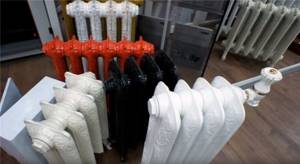
When purchasing radiators for an entire house, it is necessary to know their weight in order to calculate the carrying capacity of the vehicle and the number of loaders.
Answer for the impatient
For those who do not like to read for a long time, I will immediately indicate in the table the weight of a section of an old-style cast iron battery, and I will also write how much modern analogs made of aluminum and bimetal weigh:
| Illustration | Parameter |
| Cast iron standard:
Non-standard - from 3.7 to 14.5 kg/section |
| Aluminum.
|
| Bimetallic.
|
I foresee your question regarding weight - why is there no accurate data on cast iron? After all, you need this value to determine whether you can remove the old 10-section radiator from your apartment or house with your own hands?
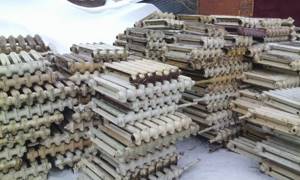
The issue of weight is far from idle - you need to calculate your strength before agreeing to work on storing old radiators.
The thing is that in operation there are models of different series, identical in purpose, but different in weight. In addition, there are a lot of models on the market that differ in size and shape from each other. Today there are more than two dozen traditional cast iron models alone, and there are almost no counting of designer floor models.
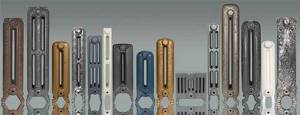
The photo shows 15 models of cast iron radiators, the weight of each varies significantly.
Indicators influencing the calculation of the number of sections
When choosing a radiator for a particular room, you need to take into account technical features. For example, the calculation will be different for a corner and non-corner room, for a room with different ceiling heights and different window sizes, etc. The most important parameters that are taken into account when determining the required radiator power are:
- the area of your premises;
- floor;
- ceiling height (above or below three meters);
- location (corner or non-corner room, room in a private house);.
- will the radiator be the main heating device;
- There is a fireplace and air conditioning in the room.
There are other important features that need to be taken into account. How many windows are there in the room? What size are they, and what kind of windows are they (wooden; double-glazed windows for 1, 2 or 3 glasses)? Was additional insulation of the walls done and what kind of insulation (internal, external)? In a private house, what matters is the presence of an attic and how insulated it is - and so on.
Cast iron radiators Conner (China)
According to SNIP, 41 W of thermal energy is required per 1 cubic meter of space. You can take into account not the volume, but the area of the room. For a 10 sq.m standard room with one door and one window, one door and an outer wall, the following heat output of the radiator will be required:
- 1 kW for a room with one window and an outer wall;
- 1.2 kW if it has one window and two external walls (corner room);
- 1.3 kW for corner rooms with two windows.
In reality, one kilowatt of thermal energy heats:
- In houses made of brick with a wall thickness of one and a half to two bricks, or made of timber and log houses (window and door area up to 15%; insulation of walls, roof and attic) - 20-25 sq. m
- In corner rooms with walls made of timber or brick of at least one brick (area of windows and doors up to 25%; insulation) - 14-18 sq. m
- In the premises of panel houses with internal cladding and a thermally insulated roof (as well as in the rooms of an insulated dacha) - 8-12 sq. m
- In a “living trailer” (wooden or panel house with minimal insulation) – 5-7 sq. m.
How much do cast iron standard ones weigh?
The common feature that unites them is the material of manufacture, namely cast iron. When we mention cast-iron batteries, the classic cast-iron accordion radiators immediately come to mind, which were installed and still serve well in:
- Preschool and school educational institutions;
- Medical institutions (hospitals and clinics);
- In all residential premises (dormitories, apartments, private houses and cottages);
- State and public organizations.
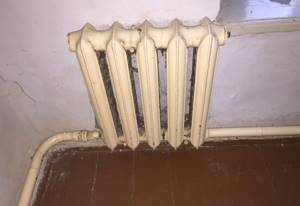
The classic example of an accordion battery can be found everywhere.
The overwhelming majority are the MS-140 or MS-90 model. There were no other mass production models observed in the past period.
To be fair, I note that in past years, the Minsk-110, NM-140, NM-150, R-90, RKSh and others models were produced in small series. Currently, they are not produced, and their scope of application was limited to regions close to the manufacturer.
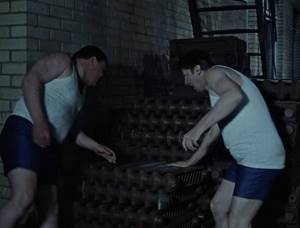
Famous movie characters had to wear radiators of the MS-140-500 series.
So what is the weight of one section of an old-style cast iron battery? What value does the factory manual contain? And here it is impossible to answer with one number, since the dimensions of the section play a role.
For example, the cast iron battery of the MS-140 series has 2 varieties (center distance):
- 300 mm;
- 500 mm.
Accordingly, if we are talking about MS-140-300, then the average weight of one fin of a cast-iron battery is 5.7 kg. And if we are talking about MS-140-500, then one such section will show 7.1 kg on the scales.

Weight depends on the dimensions of the section.
The MS-90 series is also quite common. In comparison with the 140 series, the weight of the old-style cast iron battery section is 6.5 kg at 500 mm.

For models MS-90 and MS-140, the difference lies in the shallower section depth.
Let's summarize : we have determined 3 different weights of the most common series (MS-90 and MS-140) - 6.5 kg, 5.7 kg and 7.1 kg, respectively. Can these values be considered final?
No, and here's why.

Regulatory document regulating the production of cast iron radiators
The existing standard (GOST 8690-94) describes the main parameters and dimensions of manufactured radiators. As for the weight of the sections, this standard contains a specific gravity value of 49.5 kg/kW.
This standard applies to block and cast iron heating radiators intended for use in heating systems with coolant temperatures up to 150 °C (423 K) and excess operating pressure up to 0.9 MPa (9 kgf/cm2).
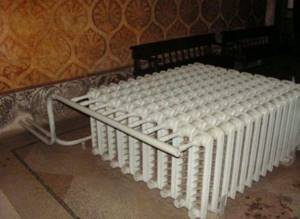
To dismantle such a monster, it must first be sawed.
In fact, the manufacturer must comply with the specified values, but the weight of a separate section is not regulated by GOST. In practice, this is expressed by the fact that the products of different enterprises differ in weight.
As of the beginning of 2021, I know the products of several enterprises that produce MS-140 radiators, their modifications and products of our own design:
- Foundry and Mechanical Plant (Ukraine, Lugansk);
- Heating equipment plant (Republic of Belarus, Minsk);
- Boiler and radiator plant (Russia, Nizhny Tagil);
- "Descartes" (Russia, Novosibirsk);
- "Santekhlit" (Russia, Bryansk).
Let's look at the product range and determine how much cast iron batteries from different manufacturers weigh.
Nizhny Tagil
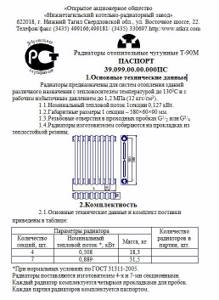
The manufacturer issues a passport for each product indicating the number of sections.
The company produces 4 models from cast iron:
| Product | Exact weight of the cast iron section of the radiator, kg |
| MS-140-M-300 | 5,40 |
| MS-140-M2-500 | 6,65 |
| MS-90 | 5,475 |
| T-90 M | 4,575 |
Manufacturer from Belarus

"Barelief" is a single-channel sectional radiator of modern design.
This manufacturer offers 9 types of cast iron radiators:
| Product | Exact weight of the cast iron battery fin, kg |
| MS-140M | 6,7 |
| B-Z-140-300 | 5,4 |
| 2K60P (two-channel sectional) | 3,7 |
| 2K60 | 5,1 |
| 2KP100-90-500 | 5,5 |
| 1K60P-60x500 (single-channel) | 3,84 |
| 2KPM-90X500 | 4,6 |
| 2K60P-300 | 3,7 |
Santekhlit
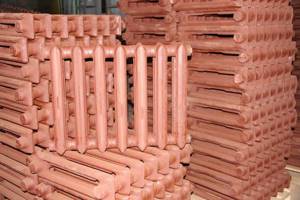
The company has been idle since last year, but its products are still sold in stores.
Let's find out how much one rib of a cast iron battery weighs - the former "Lubokhonsky Iron Foundry":
| Product | Exact weight, kg |
| MS-85 | 4,45 |
| MS-140M | 7,1 |
| MS-140-300 | 6,1 |
| MS-110-300 | 4,45 |
| MS-110-500 | 5,6 |
Types of devices by weight
It is usually customary to divide radiators into standard and non-standard. The mass range of 1 rib in the first ones, with their characteristic center distance of 300 mm and 500 mm, is 4−5.7 kg and 5.5−7.2 kg, respectively. For non-standard ones, 1 section can weigh on average from 3.7 kg to 14.5 kg.
It is possible to apply another classification. Cast iron models currently produced by manufacturers and popular among consumers can be divided into three main types
- classic (or old style);
- vintage;
- lightweight.
Classic radiators are easily recognized by their name. They are always designated by the letters “MC”, followed by two numbers separated by a dash - the depth of the sections and the center distance. Some of the most common standard models
- MS - 140 - 500;
- MS - 140 - 300.
The weight of 1 section of the first is usually 7.1 kg, and the weight of 1 rib of the second is 5.7 kg.
Representatives of the vintage type are now at the peak of popularity, despite the fact that they are the heaviest radiators of all. The weight of 1 rib can be 12 kg. Due to their heavy weight, vintage devices are classified as floor-mounted devices. These batteries look very attractive. They are produced using artistic casting technology, which makes them not just heating equipment, but a real decoration of the interior of the room.
Effect of equipment gravity
As already noted, the weight of the cast iron radiator section and the battery as a whole determines the installation principles and complexity of installation. Only based on this parameter, it is possible to determine the required carrying capacity of the transport for delivery and the sufficient number of loaders and workers.
The heavy weight of the batteries causes some difficulties during installation and installation
You cannot carry the equipment alone - only two people and with the utmost care and caution. Despite its weight and apparent strength, cast iron is a rather fragile material.
Even a light impact can cause microcracks. Subsequently, under the influence of the coolant, these microdamages will increase, which will result in depressurization of the heating equipment.
But if the base of the wall is made up of light porous blocks, this is almost impossible to do. In such circumstances it will be necessary to install the heating device on the floor.
The weight of a cast iron battery, depending on the number of sections, ranges from 7.1 kg to 71 kg.
The cast iron battery is one of the iconic inventions of the Soviet era. An ordinary heating device has become the hero of jokes and a character in films. Although what, it would seem, could be special in an ordinary heating device?
Since the invention of the water heating system in Ancient Rome, humanity has not made much progress in heating its own home. The heating devices resembled ordinary coils, but the heat did not stay in them for long and in the houses of both ordinary citizens and the palace nobility it was still cold and damp.
In 1857, in St. Petersburg, in the workshop of Franz Karlovich San Galli, the first copy of a cast iron battery was made, which is the progenitor of modern heating devices.
The weight of a cast iron battery, depending on the number of sections, ranges from 7.1 kg to 71 kg.
In shape, it was not similar to the radiators that residents are accustomed to seeing in high-rise apartments. It was a large diameter pipe, at the ends of which disc-shaped protrusions were installed, which were not part of the heating system. It was not by chance that cast iron was chosen as a material for casting; in the 19th century, steel and iron smelting production began to actively develop, so foundry masters and engineers knew a lot about their business: they valued the material for its resistance to external factors, for the fact that it was “ long-lived" and had good thermal insulation qualities.
Thanks to these parameters, the cast iron radiator has taken root in Russia. Changing shape, size and weight, it acquired today's unchanged appearance and proven production technology.
How much do non-standard cast iron weigh?
Having found out how much radiators of common series can weigh, let’s look at the parameters of non-standard products. I will say right away that there is no unity here either: both the mass and the price vary.
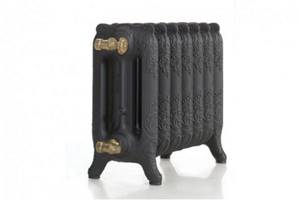
Three-channel floor-standing radiator from a French manufacturer.
One section of the Guratec Apollo 795 model weighs 13.5 kg. Sold in sections of 7 with a total weight of 94.5 kg, so several people are needed during unloading and installation.

The appearance of the classic cast iron radiator is undergoing changes, subject to the influence of fashion trends
The “cheaper” Czech manufacturer Viadrus produces Kalor 500×160 cast iron radiators whose section weight is 5.6 kg.
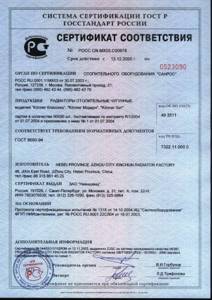
Imported products undergo mandatory certification for compliance with GOST, but the weight of the section is not taken into account during testing.
Classic batteries: basic parameters
The Soviet MC140 battery with the following parameters is considered classic
:
- height 388/588 mm;
- depth 140 mm;
- width 93 mm;
- the volume of one link with a height of 588 mm is 1.5 l;
- the weight of one link with a height of 588 mm is 7.12 kg.
Knowing how much one radiator section weighs and its volume, you can calculate the mass of the MC140 heating device filled with coolant. The total mass of the filled section will be 8.62 kg, a battery of 10 links will weigh about 86 kg.
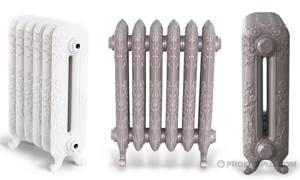
Wide selection of different battery styles
Surface treatment: sanding
Such heating devices require frequent painting , as scratches or chips remain on them.
If you change the color of the heating device, the entire room may need to be renovated. The process of updating the radiator color is divided into several stages.
The first stage includes surface preparation. First , thoroughly rinse the battery, remembering to remove traces of dirt between sections.
After that , remove the layer of old paint - for this there are many special solutions that do not harm the metal. The solution is applied to the heating device with a dry brush and the radiator is wrapped with film. After an hour, the paint is removed using a spatula. Afterwards, carefully sand the surface of the battery with fine-grained sandpaper and degrease it with a solvent. If there are areas touched by rust on the battery, they are processed to bare metal.
Applying a primer will complete the process of preparing the product - after that, begin painting. The paint will lie on the surface in a beautiful, even layer. The primer will also help fight corrosion.
Coloring
Radiator paint must meet many requirements:
- be abrasion resistant and non-toxic;
- withstand temperatures of more than one hundred degrees , for example, those containing metal powder are considered the most heat-resistant;
- must be suitable for painting metal surfaces;
- fit under the primer;
- help protect the product from corrosion processes;
- serve for a long time , maintaining color.
Glossy shine and long-lasting color will be given to radiators by acrylic enamels containing organic solvents. However, they have a serious drawback - a strong unpleasant odor during the dyeing process.
Alkyd enamels apply smoothly and are resistant to abrasion. However, a pungent odor from them is present not only during application, but also for a certain period of time after complete drying when the radiator is heated.
Photo 1. Jar of heat-resistant alkyd enamel for heating radiators, 0.5 l, manufacturer Dali.
To prevent paint drips from spoiling the already painted surface, it is recommended to start painting from the top of the battery.
Important. We must remember that you cannot paint hot batteries.
Applying a second layer
When the first layer of paint has dried (drying time depends on the quality of the paint, but on average it is twenty hours ), another layer is applied. This allows you to hide irregularities on the surface of the radiator, increase the resistance of the painted surface to external influences and improve the aesthetic appearance of the radiator.
Attention! Do not turn on the batteries until the paint is completely dry. Do not artificially speed up the drying process - this can lead to negative consequences.
Modern heating radiators made of cast iron
For wall mounting, there are new products made of gray cast iron from various manufacturers, whose weight is much less than traditional MS 140. For example, the Czech heating radiator Viadrus STYL 500, shown in the figure.
Its characteristics are as follows: weight of 1 section – 3.8 kg, water capacity – 0.8 liters, a total of 4.6 kg. With an available heat flux of 140 W, our room of 20 m2 will require 14 pieces, which will weigh 64.4 kg including water. This figure is 40% less than that of MS 140, and dividing it into 2 parts (32 kg each device), it becomes clear that it is possible to install cast iron radiators on walls made of porous concrete without special additional considerations. An even lighter design is offered by a Russian manufacturer that sells its heating devices under the EXEMET brand, namely the MODERN model.
Here, one radiator section weighs only 3.2 kg with a heat transfer of 93 W; a room of 20 m2 requires 22 sections with a total weight of 70.4 kg. This indicator is also quite good, especially considering that the company manufactures these batteries with the possibility of floor installation.
It is impossible not to say a few words about such a product as a vintage cast-iron battery, whose weight is even greater than the Soviet MS 140 and in some cases reaches 14 kg. These heating devices in their appearance resemble the ancient ones installed in residences and estates back in the 19th century.
The EXEMET FIDELIA model shown in the figure weighs 12 kg with a heat output of 156 W, which makes the total weight of the cast iron radiator for our example simply monstrous - 154 kg. But as you can see in the image, here the installation issue is solved differently: the first and last sections have legs for placing the heater on the floor.
What is the weight of one section of a cast iron radiator?
Cast iron radiators appeared more than a hundred years ago, and are still in demand. Of course, the peak of their popularity is behind us - it occurred in the middle to end of the last century. Despite the fact that cast iron batteries have obvious advantages, they have disadvantages. More precisely, there is only one drawback - a lot of weight. The weight of one section of a cast iron heating radiator is seven and a half kilograms, respectively, an average-sized battery consisting of seven sections will weigh 50 kilograms.
General characteristics of cast iron radiators
An ordinary cast iron radiator usually consists of 5-10 sections. The number of sections depends on the desired thermal effect. The more sections, the greater the heat transfer and temperature in the house. Moreover, you can install a radiator consisting of any number of sections: cast iron batteries, as well as bimetallic ones, can be divided. This will create the most comfortable environment.
Radiators of Soviet apartments
Heavy weight is not a problem during operation: the main thing is to install the battery correctly. You can find out how much a cast iron radiator weighs in 10 sections by simple calculations. One section of a modern radiator weighs 7.1 kilograms, which means 10 sections will weigh 71 kilograms.
Despite the fact that the popularity of cast iron batteries is no longer so great, one cannot fail to mention their advantages.
https://youtube.com/watch?v=x7I5HOChqig
Here are some of them:
- resistance to corrosion;
- thick walls, which are a guarantee of durability;
- the ability to use coolants of any quality;
- excellent heat storage capacity;
- long service life;
- large internal cross-section, thanks to which cast iron radiators do not have to be cleaned often.
MS-140 batteries made in Belarus
Standard models of cast iron batteries have a center distance of 300 or 500 millimeters. However, there are also models that have a greater height - the center distance of which reaches 800 millimeters. In addition, intermediate models are produced in which the center distance is 350 millimeters. The depth can be different - 110, 99 or 92 millimeters. The width of cast iron radiator sections ranges from 35 to 60 millimeters.
The situation in the modern market
Although not on the same scale as since the times of the USSR, cast iron radiators are still produced today. For example, cast iron radiators MS-140, which are in high demand, are manufactured in Minsk and Lugansk. The radiators have almost the same characteristics, with the exception of one thing - color. Minsk residents produce red radiators, the Lugansk plant produces gray ones.
Modern antique radiator
Modern cast iron radiators are made from high quality cast iron. This largely determines their parameters and stability of characteristics, including weight. In particular, regardless of the delivery batch, the weight of 1 section of the MS-140 cast iron radiator is 7.1 kilograms. Thanks to this, during the design calculations it is possible to determine the load that will be experienced by the walls to which the heating radiators will be attached.
Belarusian and Ukrainian factories, of course, are not the only enterprises producing cast iron batteries. Since recently such products are in increasingly high demand, radiators are produced in various colors and sizes. In addition, batteries decorated with casting and imitating antique products have recently appeared on the market. This significantly increases interest in products of this type.
How much water is in one section of an aluminum radiator, methods for calculating volume
Nowadays, replacing old cast-iron batteries with new models has become not a tribute to fashion, but a vital necessity. Concern for the safety of the heating system and attempts to reduce the cost of utilities have led to more and more consumers choosing aluminum radiators, which differ from other types of heaters in both technical characteristics and price. One of the important parameters is the volume of the heating radiator.
Parameters of aluminum radiators
The technical characteristics of heating batteries are the first thing a consumer pays attention to before purchasing. The most important indicators of a truly high-quality product are:
- The level of heat transfer of one section, since it depends on:
- First, how many elements are needed to heat one room.
- Secondly, how warm the room will be thanks to the radiator.
- Thirdly, what will the microclimate in the room be like?
- Resistance to water hammer and operating pressure of an aluminum radiator.
- Cost of the finished product.
The volume of one section of an aluminum radiator indicates its power and largely depends on how it was manufactured.
If the aluminum battery was made by pressing, then its parts were connected using glue, which makes it vulnerable. Such a radiator is not afraid of corrosion, but increased pressure can damage it.
The capacity of one section of an aluminum radiator, regardless of the method by which it was produced, is almost the same, but the fact that the cast model is stronger and more durable, heats up faster and can be adjusted in size puts them in first place in sales.
Types of coolants
As a rule, the question of what coolant is used in a centralized heating system is not asked, since water always flows through the heating pipe there. Another thing is autonomous heating, where you can choose the best option for a particular house, taking into account the climate of the region where it is built.
Why is radiator volume important?
Calculating how many liters are in one section of an aluminum radiator is important for several reasons:
Considering how many factors are affected by the volume of heating batteries, this parameter should be taken into account when choosing aluminum products.
Calculation of the volume of an aluminum radiator
There are two ways to determine the capacity of a heating battery:
This, although a very labor-intensive method, is the most reliable and accurate, since manufacturers can overestimate or underestimate the parameters of their products in the technical documentation.
When choosing the type of radiator, you should pay attention to the difference in the parameters of domestic and foreign manufacturers. Some indicators may look very attractive, but are not suitable for the centralized Soviet heating system. You also need to think in advance which coolant in the network will be used, and make calculations indicating its viscosity
You also need to think in advance which coolant in the network will be used, and make calculations indicating its viscosity.
To summarize, we can say that the volume of an aluminum radiator is an important parameter that must be taken into account in order for the system to work truly efficiently in the future.
